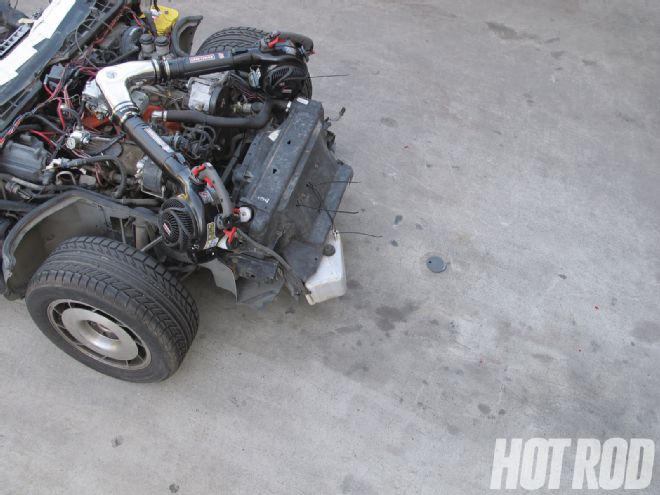
Much like the time we saw a video of a guy trying to do a brodie in his brand-new Corvette and mistaking his burning clutch for tire smoke, we were left shaking our heads once again as we watched a Streetfire.net video of a dyno shop pointing a leaf blower at the intake of a ’93 GMC Sonoma pickup and claiming it made power. A leaf pusher that somehow made boost inside a 4.3L V6? We had to call shenanigans. In fact, we attempted to phone the shop via the information listed at the end of the video. No luck there; the phone number was bunk, which further served to peg our BS meter.
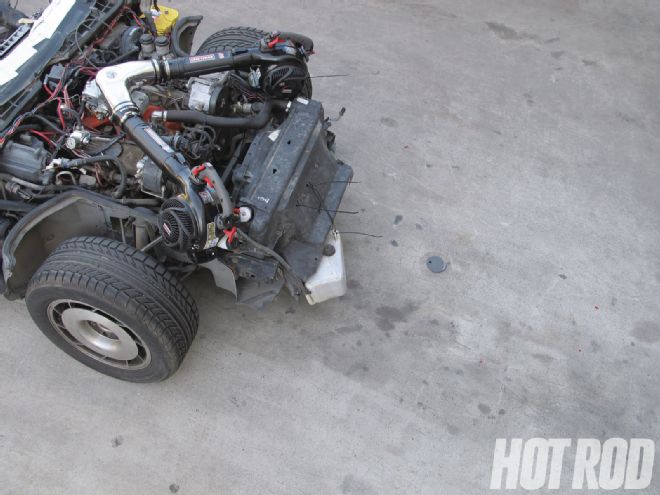 A carb spacer would have provided enough cowl clearance to flip the leaf blowers around 180 degrees, allowing us to pull-start them from inside the Vette.
A carb spacer would have provided enough cowl clearance to flip the leaf blowers around 180 degrees, allowing us to pull-start them from inside the Vette.
Since the Internet is the de facto supplier of bad info in today’s gearhead universe, we had to find out for ourselves if a leaf blower could actually build boost and add power to an engine. And since our Corvette has sat dormant since we put it on a crash diet plan in the Nov. ’10 issue (Vette Hack), we figured it was only fair that it get some love in the form of a little redneck engineering.
A quick study of the commercial and residential blower units on the market made an easy choice for our weapon of mass distraction. We skipped the AC-powered units because dragging an extension cord down the quarter-mile wouldn’t fly even at the seediest of racing facilities. Putting a heavy generator inside the car would be counterproductive to the crackhead diet we’d already put the car on. Although they blow harder than the rest, the backpack-style commercial leaf blowers are too heavy and expensive to justify installing onto a car as cheap as the Vette, leaving portable gasoline models as the obvious choice. Overcoming atmospheric pressure inside 350 ci of a GM internal combustion engine meant we needed some serious flow, so we bought not one but two 470-cfm Craftsman, two-stroke blower units for $139.99 apiece. They weigh 11 pounds each and are small enough to hide in a car that still has a body on it. We have no shame, so we didn’t bother hiding ours. Before we could test our new suppliers of cfm, though, we had to give the Vette some much-needed attention.
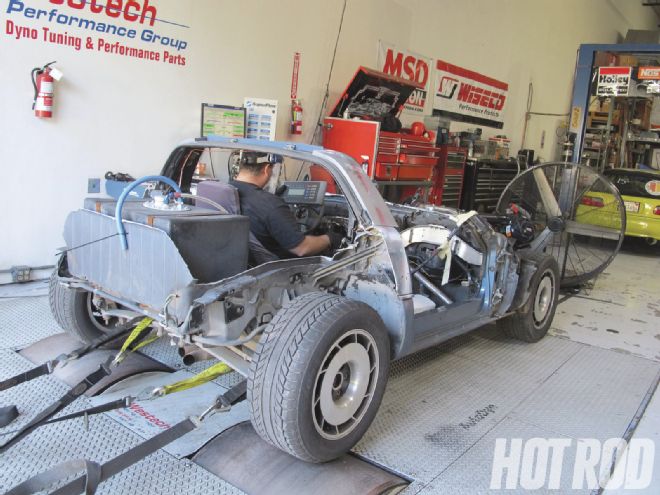 The “Vette Hack” diet turned our beat-down C4 into a lightweight, man-sized go-kart. It’s still short on power, though. Dyno tuning the small-block helped. Twin blowers helped even more.
The “Vette Hack” diet turned our beat-down C4 into a lightweight, man-sized go-kart. It’s still short on power, though. Dyno tuning the small-block helped. Twin blowers helped even more.
The C4 never ran right to begin with because after rescuing the car from the desert we only spent an hour getting the L98 running before the Vette Hack test. We swapped the factory TPI and computer system for a Torker intake, a 750 Demon carb, and an HEI ignition, but spent zero time tuning any of it. Since then, the car has sat outside during a few freak Southern California rainstorms, which filled the crankcase with about 5 quarts of water thanks to a missing grommet in one of the valve covers. Our first task was to the change the oil, tweak the carb and ignition timing, and get the engine happy again.
Happy means it produced 274.3 lb-ft of torque at 2,878 rpm and 213.6 hp at 4,463 rpm with the air/fuel ratio in the high 12:1 to low 13:1 range on Westech Performance Group’s chassis dyno. We were shocked it broke the 200hp mark because before we cut 1,250 pounds off the chassis, the car ran like the hamster hadn’t been fed for a month. It wasn’t going to win a drag race with a Geo Metro, and something had to be done.
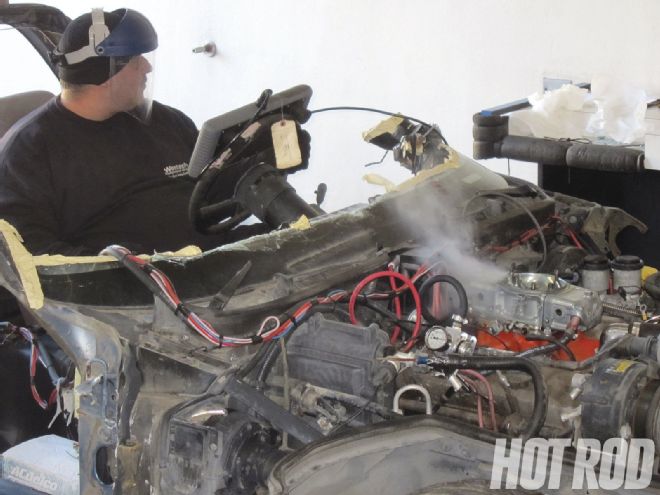 It’s a rare occurrence when a dyno operator feels unsafe driving a car on the dyno without a face shield. Ernie Mena dodged hot water coming from the L98 during the first pull.
It’s a rare occurrence when a dyno operator feels unsafe driving a car on the dyno without a face shield. Ernie Mena dodged hot water coming from the L98 during the first pull.
Hooking up both blowers to our carbureted engine couldn’t have been easier. We dropped another $133.95 on a Spectre Performance carb hat with twin 4-inch inlets, silicone hose reducers (4 to 3 inch), and four hose clamps. We used the 3-inch plastic tubing included in the leaf blower kits to plumb the system. A few cable ties and 10 minutes later, the first blower was resting comfortably and semisafely on what was left of the Vette’s core support, ready to push or have hot air sucked through it and into the carburetor.
We were eager but not overly optimistic when we primed the carb on the leaf blower, tugged on the pull starter a few times, and held the throttle wide open using the built-in cruise control feature. Manufacturer propaganda on the Craftsman blower stated that it was pushing air into the carb hat at 215 mph. We had our doubts that it was blowing harder than the L98’s pistons were sucking air in, but sure enough, the dyno data-logged more than half a pound of boost pressure down low in the rpm band where the torque jumped 23 numbers to 297.9 lb-ft at 2,946 rpm. Although the boost decreased as the engine speed went up, the power increase was maintained until redline. Peak power also climbed 10.4 points, reaching 224.1 hp at 4,546 rpm. The air/fuel ratio was 13:1 at the bottom and 12.7:1 up top. It was on like Donkey Kong.
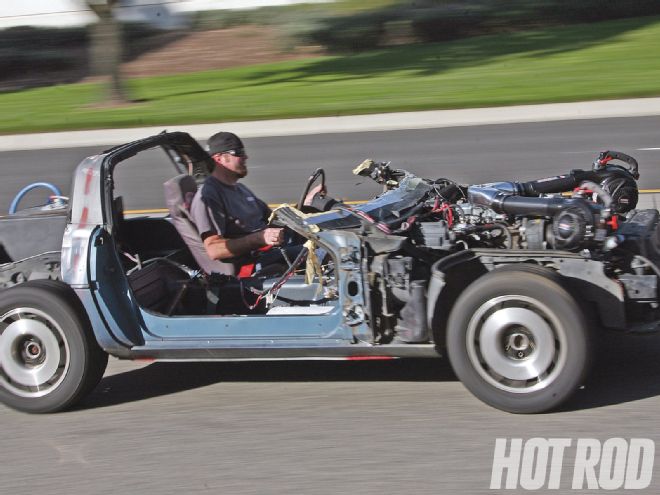 Spraying nitrous oxide across the barrels of the carburetor works, too. A fitting drilled with a 0.075-inch orifice threaded into the end of the supply line made sure we didn’t unleash a 400-shot on the unsuspecting engine without any additional fuel, no matter how much we turned the knob on the bottle regulator.
Spraying nitrous oxide across the barrels of the carburetor works, too. A fitting drilled with a 0.075-inch orifice threaded into the end of the supply line made sure we didn’t unleash a 400-shot on the unsuspecting engine without any additional fuel, no matter how much we turned the knob on the bottle regulator.
Like kids who just scored a new toy from Santa, we threw a few more main-jet sizes into the secondary side of the carburetor and rushed to plumb the second blower. Having twins strapped to the Vette makes this mod even more hilarious, but you can’t argue with something that looks so ridiculous when it works. The second blower combined with the first one to give the engine a full pound of boost down low and pushed the torque number to 303 lb-ft at 3,234 rpm. It also helped maintain positive pressure inside the manifold as the engine speed increased. The dyno recorded almost half a pound of pressure at the top of the rpm band and the power went up to 237.1 hp at 4,587 rpm. That’s an increase of almost 24 hp and 28.7 lb-ft of torque over the stock numbers. Best of all, the bump in power is present across the entire powerband and was better by almost 50 hp at the low end.
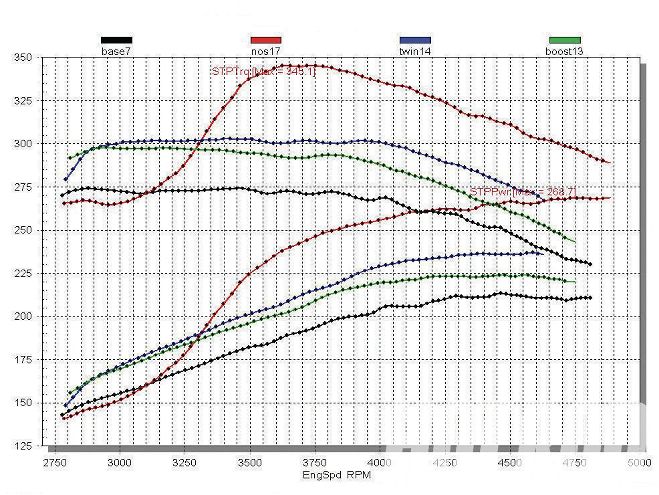 The dyno doesn’t lie. The blue lines represent the engine without any power-adder. The green lines are the single leaf blower dyno pull. The red lines are the twins. The black lines kick in higher in the rpm band after we opened up the nitrous bottle without the blowers in play. HRM
The dyno doesn’t lie. The blue lines represent the engine without any power-adder. The green lines are the single leaf blower dyno pull. The red lines are the twins. The black lines kick in higher in the rpm band after we opened up the nitrous bottle without the blowers in play. HRM
It turns out that leaf blower technology works, and not just on smaller engines. But, is it worth the money to cobble together your own HOT ROD Garden Package? Well, the blowers can be removed easily and are useful around the house. The system is pretty cheap, too, though in truth you could have bought a nitrous unit for what we spent, Some garage-sale shopping could cut this deal to a tenth of the price. We can’t picture anyone stuffing twin plastic huffers under the hood of a car that doesn’t fit the, uh, theme of a ghetto fabulous mod like this one, but it could be a fun add-on for a 24 Hours of LeMons car, or perhaps to attract dates. And we have to admit, the additional power is nothing to write home about. In fact, for the sake of comparison, we quickly installed a dirt-cheap nitrous system on the Vette by attaching the supply line from a nitrous bottle right in front of the carburetor that sprayed nitrous across the top of it. No solenoids, no fuel system mods, and no real way to ensure the engine wouldn’t melt down. The gains were substantial though, with the nitrous besting the leaf blowers by 50 hp across the board. Cheap power rules, and this time the Internet didn’t lie to us!
 We practice what we preach. The Vette hit the streets with 940 cfm of dirt-cheap blower up front, and it was a riot to drive. The Craftsmans were loud; much like a with a Roots blower, you heard the leaf blowers coming at you before the exhaust note. The looks from other drivers were priceless.
We practice what we preach. The Vette hit the streets with 940 cfm of dirt-cheap blower up front, and it was a riot to drive. The Craftsmans were loud; much like a with a Roots blower, you heard the leaf blowers coming at you before the exhaust note. The looks from other drivers were priceless.